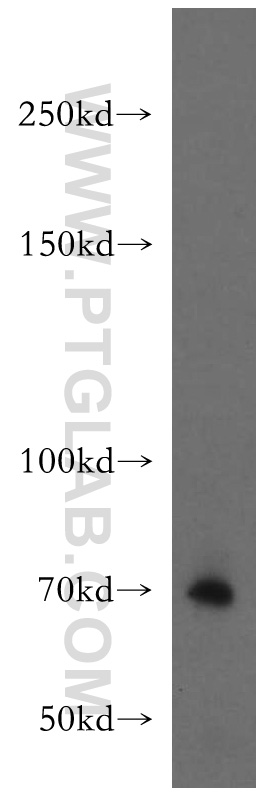验证数据展示
经过测试的应用
| Positive WB detected in | mouse brain tissue |
| Positive IP detected in | mouse brain tissue |
推荐稀释比
| 应用 | 推荐稀释比 |
|---|---|
| Western Blot (WB) | WB : 1:500-1:2000 |
| Immunoprecipitation (IP) | IP : 0.5-4.0 ug for 1.0-3.0 mg of total protein lysate |
| It is recommended that this reagent should be titrated in each testing system to obtain optimal results. | |
| Sample-dependent, Check data in validation data gallery. | |
产品信息
11394-1-AP targets FBF1 in WB, IP, ELISA applications and shows reactivity with human, mouse, rat samples.
| 经测试应用 | WB, IP, ELISA Application Description |
| 经测试反应性 | human, mouse, rat |
| 免疫原 | FBF1 fusion protein Ag1954 种属同源性预测 |
| 宿主/亚型 | Rabbit / IgG |
| 抗体类别 | Polyclonal |
| 产品类型 | Antibody |
| 全称 | Fas (TNFRSF6) binding factor 1 |
| 别名 | Alb, albatross, Fas (TNFRSF6) binding factor 1, FBF 1, FBF1, FBF1 Ens, HCG1989313, isoform CRA_b, KIAA1863 |
| 计算分子量 | 1133 aa, 125 kDa |
| 观测分子量 | 69-70 kDa |
| GenBank蛋白编号 | BC012332 |
| 基因名称 | FBF1 |
| Gene ID (NCBI) | 85302 |
| RRID | AB_10638320 |
| 偶联类型 | Unconjugated |
| 形式 | Liquid |
| 纯化方式 | Antigen affinity purification |
| UNIPROT ID | Q8TES7 |
| 储存缓冲液 | PBS with 0.02% sodium azide and 50% glycerol , pH 7.3 |
| 储存条件 | Store at -20°C. Stable for one year after shipment. Aliquoting is unnecessary for -20oC storage. |
背景介绍
FBF1, also named as ALB and KIAA1863, is keratin-binding protein required for epithelial cell polarization. It is involved in apical junction complex (AJC) assembly via its interaction with PARD3. FBF1 is required for ciliogenesis. FBF1 has six isoforms with MW 125-127 kDa, 99 kDa, 69 kDa and 55 kDa. This antibody is induced by the fragment (492-792aa) of FBF1. It recognizes isoform 1, 2, 3, 5 and 6.
实验方案
| Product Specific Protocols | |
|---|---|
| WB protocol for FBF1 antibody 11394-1-AP | Download protocol |
| IP protocol for FBF1 antibody 11394-1-AP | Download protocol |
| Standard Protocols | |
|---|---|
| Click here to view our Standard Protocols |

